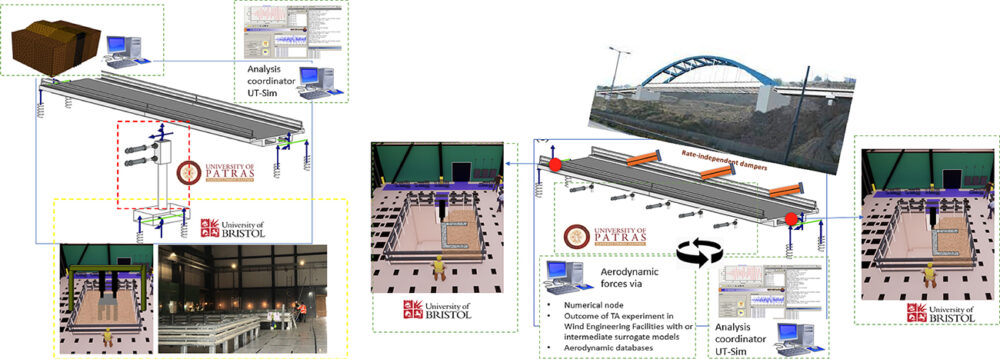OBJECTIVES:
Provision of access to the following infrastructure(s):
SoFSI/EQUALS (UBRI) and STRULAB (UPAT) (joint, synchronous access for Hybrid Simulation)
Name of the infrastructure and its installations:
UKCRIC National Facility for Soil Structure Interaction (SoFSI) and EQUALS (hereafter: SoFSI/EQUALS RI) – STRULAB RI
Location (town, country) of the infrastructure:
Bristol, UK and University of Patras, Greece
Web site address:
https://sofsi.bristol.ac.uk and www.strulab.civil.upatras.gr
Reference contact for potential TA user groups:
Anastasios Sextos – a.sextos@bristol.ac.uk
George Mylonakis – G.Mylonakis@bristol.ac.uk
DESCRIPTION OF THE INFRASTRUCTURE:
This WP refers to a joint access to two RIs (UBRI-UPAT) for conducting geographically distributed Hybrid Simulation (HS), to enable collaborative research across geographical boundaries and support blue sky, curiosity-driven research irrespective of location. Hybrid Simulation (HS) is a novel multi-site, on-line, computer-controlled integrated testing-analysis scheme, where part of the structural system of interest can be simulated numerically, while other sub-components (i.e., typically the ones with the most critical or nonlinear behavior), are tested physically. Hybrid Simulation combines the most attractive features of both testing and analysis, to provide test results of enhanced reliability even for very complex structures and infrastructure. The numerical to physical coupling is achieved via a transfer system comprising of a test frame (e.g., UPAT), a soil pit (e.g., UBRI) or other entities, actuators, sensors and an interface analysis coordination program which links the physical part to the numerical one. The main advantage of this coupled experimental and computational approach is that different equipment and experimental infrastructures, but also different analysis platforms can be combined to realistically study the response of complex systems to environmental loads that would be impossible to be explored within a single facility.
STRULAB is among the few European laboratories employing the hybrid simulation method with distributed hybrid simulation, comprising international participation. SoFSI/EQUALS on the other hand, is a node of the UK Network for Earthquake Engineering Simulation (UK-NEES), which forms part of the world wide NEES. NEES promoted for years participation of remote users in experiments via high performance video conferencing and, where appropriate, direct interactivity and control of test and data acquisition equipment, enabling senior researchers to interact remotely with their junior staff at the lab. Examples of successful UBRI and UPAT RIs involve local Hybrid Simulation within a single site (case of structure-pipe-structure interaction in a natural gas pressurizing station studied in the framework of the H2020 project EXCHANE-Risk) and distributed HS across multiple sites (case of a seismically excited bridge-soil system tested in the framework of the FP7 project EXCHANGE-SSI).
From the side of UBRI, a proposal may choose to utilize any of the four installations provided, that is: (a) the 6m x 4m biaxial shaking table with a 50t capacity, capable of meeting BELLCORE test standards with a peak acceleration at 2g and maximum frequency of 50Hz, (b) the 6m x 5m x 4m soil pit, (c) the Hexapod or (d) the 3m by 3m, 6DOF shaking table. The corresponding installation in the STRULAB of the UPAT installation includes a 18x16m strong floor and two, 5.5m-tall orthogonally placed, strong walls for uniaxial or biaxial testing. For a detailed description of the two collaborating Laboratories reference can be made to the individual presentation provided in WP9 and WP5 for UBRI and UPAT, respectively.
Services currently offered by the infrastructures:
Given that the experiments to be conducted in the framework of this WP will take place in (at least) two sites, the users will take advantage of the combined services of the involved RIs. For more details one can refer to the individual WP9 and WP5 for UBRI and UPAT, respectively.
The tests can conceptualize a wide range of structures and infrastructures, typically of large dimensions, for which sub-structuring and geographically distributed HS can be highly beneficial due to their size (and scale) limitations or because the required equipment is not available in a single facility. Such potential proposals for joint TA access may involve cutting edge, multi-disciplinary, multi-hazard research on long bridges, special, irregular and base isolated buildings, offshore wind turbines, nuclear industry applications as well as lifelines (water, wastewater and natural gas pipelines) among others. The envisaged Hybrid Simulation between UPAT and UBRI will also enable consideration of soil and its dynamic interaction with the foundation and the superstructure which is impossible to be combined with testing of a large structure within the same laboratory. To demonstrate the feasibility of the proposed TA scheme, indicative examples are shown in the figure below for researching the response of a bridge under earthquake and wind loading, while testing experimentally the contribution of the pile group foundation of the pier or that of abutment-embankment interaction.
Because of latency limitations (such as internet network delays) that hinder the execution of geographically distributed Real-Time Hybrid Simulation (RTHS), the tests to be performed shall involve rate-independent phenomena (e.g., a sand damper) or materials, for which (non-continuous, non-real time) pseudo-dynamic testing at an extended time scale among remote sites is a challenging, yet feasible approach.



